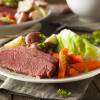Friends sometimes ask me how I built a well-stocked home bar. But I can’t say that there was any rhyme or reason to my process. In fact, I probably learned mostly by error.
It’s easy to become overzealous when experimenting with new cocktail recipes and buy bottles of single-use liquors that end up relegated to the bottom shelf to collect dust and take up space. (I’m looking at you, Godiva Liqueur.)
I’m here to tell you that you don’t need endless bottles of liquor at home to make a quality craft cocktail.
A well-curated liquor cabinet can make you into a cocktail-crafting guru in no time! I’ve paired down my cabinet to fifteen bottles that are my go-to liquors when mixing drinks for friends and family at home.
Remember, you don’t need it all right away! Take your time building a bar, and make sure you account for your own personal tastes.

Up First: The Basics
The best place to start is with your base spirits. When stocking the basics, first consider who your audience is. Are you mixing for just you? You and a partner? Perhaps you’re getting ready to host some guests? Start small with one or two liquors that you know you (and your guests) will like—and you know how to use.
When I first began making cocktails at home, gin was my jam! It’s herbal notes played well with citrus and simple syrups that I already had in the house, and it’s easy to transition gin from season to season. If gin isn’t your thing, no worries! Pick something you’ve tasted before at a bar and you know you enjoy, so that your hard-earned money isn’t gone to waste.
1. Gin: Pairs with tonic, lemon, lime, lavender, rosemary, rhubarb and egg white.
Recommended:
Berkshire Mountain Distillers Ethereal Gin
2. Tequila: Pairs with citrus of all kinds, chocolate and chiles.
Recommended:
Cuervo Tradicional Reposado
3. Vodka: Pairs with soda or tonic, lemon, orange, strawberry, salt and acids.
Recommended:
Tito’s
4. Bourbon: Pairs with bitters, orange, spices, mint, cherry and egg yolk.
Recommended:
Bulleit
5. Rum: Pairs with citrus, cherry, almond, mint, allspice, cinnamon and vanilla.
Recommended:
Privateer True American Rum
Next Up: The Supporting Spirits
If you’ve got the bases covered, you’re already well on your way to mixing great drinks. But let’s take it a bit further, as there are some excellent and easy craft cocktails that only need a few more ingredients. Again, think back to some of your favorite drinks enjoyed at the bar. Are there any reoccurring characters in your drinks? Consider picking those up first.
Master mixing one or two cocktails using a few of these key ingredients. Once you’ve gotten them down, think about substituting one ingredient for another, or adding in another flavor to give another dimension to your drink.

6. Brandy: A winter staple for me. It’s great to cook with, and some of my favorite cold-weather cocktails—like the Vieux Carré and Sidecar—use some form of brandy (typically the grape or apple variety).
Recommended:
Laird’s Applejack
7. Orange Liqueur: A regular in my home, especially in the summer. Orange liqueur pairs with every base spirit, and is a key ingredient in many classic craft cocktails.
Recommended:
Cointreau
8 & 9. Vermouth: I keep small bottles of both sweet and dry vermouth on hand to mix into manhattans, negronis and martinis.
Recommended:
Dolin Blanc
(dry) and
Martini & Rossi
(sweet)
10. Elderflower Liqueur: Floral and sweet in scent and flavor, elderflower liqueur is gin’s bosom buddy. It’s a perfect pick for spring and summertime drinks.
Recommended:
St. Germain
, or, for a local pick,
St. Elder
11. Creme Yvette : Subtly sweet with hints of berries and vanilla, Creme Yvette is a beautiful purple color, so it'll make your drinks taste good and look pretty, too! Try shaking up a classic craft cocktail, the Aviation, which pairs Creme Yvette with gin, maraschino liqueur and lemon juice.
12. Chartreuse : Distinctly herbal, chartreuse comes in yellow and green varieties. While yellow chartreuse is sweeter and more forgiving, I prefer green chartreuse, which was the first of the two that I acquired for my home bar. Use it to mix a Last Word cocktail, which is made with gin, maraschino liqueur, lime juice and chartreuse.
13. Campari : Some will be turned off by Campari’s intensely bitter herbal flavor. It is certainly an acquired taste, but worth warming up to. Start off by trying a Campari and soda, or jump right in with a negroni or one of its variations.
14. Aperol : Now owned by the Campari Group, Aperol is another Italian aperitif with notes of sweet and bitter oranges, and an vibrant orange coloring to match. I think Aperol is more approachable for those new to bitter liqueurs than Campari. Pair it with gin or vodka for an Instagram-worthy cocktail!
15. Amaro: Amaro is an Italian after-dinner digestif that has established a sort of cult following in craft cocktail bars across the country. Up until a few years ago, I only knew of two or three different amaro varieties, and finding them in the liquor store was no easy feat. But as consumer knowledge of them grows, it is becoming slightly easier to get your hands on some great quality amaro. Enjoy a splash on the rocks or in a snifter on its own—or get adventurous and mix it into a cocktail!
Recommended:
Amaro Nonino Quintessensia
Consider looking outside of your liquor cabinet for ingredients to use in your craft cocktails. Lemons, limes and oranges can be fresh-squeezed for their juices. Sugar and water can be combined to make simple syrup. Once simple syrup is made, it can be infused with endless flavors that will add dimension to your drinks.
Lastly, I strongly recommend keeping a few types of bitters on hand to add to your drinks when needed. Although used in very small quanitities, bitters pack a flavor punch that is hard to replace with a substitute. A few bitters to start with are Angostura , Peychaud’s , and orange bitters ( Regan’s #5 Orange Bitters is my pick).
Cheers, friends! You’re well on your way to a home bar to rival them all.




